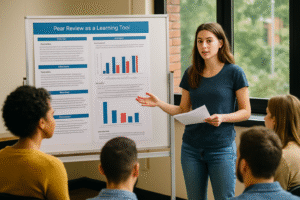
Adapting Educational Approaches to Neurodiversity -Tailoring Teaching Methods to Individual Cognitive Styles
In today’s classrooms, the phrase “one size fits all” is rapidly becoming a relic of the past. With the growing recognition of neurodiversity, educators and institutions are now challenged—and indeed, inspired—to adapt their teaching methods to meet the unique cognitive profiles of every learner. This article explores how educational approaches can be tailored to support neurodiverse students, from those with ADHD and autism to learners with dyslexia and beyond, all while keeping the tone accessible, engaging, and, yes, a little humorous.
Understanding Neurodiversity
At its core, neurodiversity celebrates the natural variations in human brain function. Just as biodiversity strengthens an ecosystem, neurodiversity enriches our communities by bringing different perspectives and strengths. Neurodivergent individuals, whether they exhibit ADHD traits, sensory processing differences, or specific learning disabilities like dyslexia, often process information in ways that differ from the neurotypical norm. Recognizing these differences is the first step toward creating educational environments that empower all learners.
The Need for Adaptation in Education
Traditional educational models tend to favor uniformity—standardized tests, fixed lesson plans, and rigid classroom structures. Yet, when the goal is to maximize every student’s potential, a one-size-fits-all approach can be counterproductive. The key is flexibility. Adapting teaching strategies to the specific needs of neurodiverse students can mean the difference between a disengaged learner and a thriving one. Let’s delve into some practical approaches tailored to various neurodivergent profiles.
Tailored Approaches for Different Neurotypes
For Students with ADHD
Learners with Attention Deficit Hyperactivity Disorder (ADHD) often struggle with prolonged focus and may benefit from dynamic, interactive learning environments. Here are some strategies:
- Breaks and Movement: Incorporate short, scheduled breaks that allow for physical movement. Even a brief stretch or a quick walk can help reset attention.
- Interactive Lessons: Use hands-on activities and technology-assisted learning tools that keep students engaged. Think along the lines of interactive whiteboards or gamified learning platforms.
- Clear, Concise Instructions: Provide instructions in manageable segments, ensuring that each step is clearly outlined. This reduces the cognitive load and minimizes distractions.
For Autistic Learners
Students on the autism spectrum might thrive in environments where predictability and structure reign supreme:
- Structured Environment: Maintain a consistent routine and clear expectations. Visual schedules can be extremely helpful.
- Sensory Considerations: Adjust classroom lighting, sounds, or seating arrangements to create a comfortable sensory environment.
- Visual Supports: Use diagrams, flowcharts, and other visual aids to complement verbal instructions. This can make abstract concepts more concrete and accessible.
For Students with Dyslexia
Dyslexic learners often encounter challenges with traditional text-heavy approaches. Here’s how educators can help:
- Multi-Sensory Teaching: Engage multiple senses through a blend of auditory, visual, and kinesthetic learning experiences. For instance, combining reading with speaking and hands-on activities can reinforce understanding.
- Assistive Technologies: Tools such as text-to-speech software and audiobooks allow students to access content without being hindered by reading difficulties.
- Alternative Assessment Methods: Consider oral presentations or project-based assessments as alternatives to conventional written tests.
For Other Neurodivergent Profiles
Neurodiversity is not confined to these categories alone. Many learners might experience challenges related to executive functioning, anxiety, or sensory processing. Educators should:
- Promote Self-Advocacy: Encourage students to identify their learning preferences and communicate their needs. When students are aware of their strengths and challenges, they can collaborate with teachers to find the best solutions.
- Flexible Curriculum Design: Build a curriculum that allows for different modes of learning and assessment, ensuring that no student is left behind simply because they process information differently.
- Collaborative Learning: Foster group work and peer-to-peer support, which can provide multiple avenues for understanding and engagement.
Best Practices for Inclusive Education
Adapting educational approaches isn’t solely about tweaking lesson plans—it’s also about cultivating an inclusive mindset among educators, administrators, and peers. Here are some guiding principles:
- Professional Development: Continuous training for teachers on neurodiversity ensures that they are equipped with the latest strategies and understanding.
- Technology Integration: Leverage digital tools and platforms designed to meet diverse learning needs. From virtual reality simulations to adaptive learning software, technology can be a powerful ally.
- Collaborative Planning: Engage students, parents, and specialists in the planning process. When all voices are heard, the resulting educational strategies are more robust and effective.
- Humor and Humanity: A touch of humor can work wonders in reducing anxiety and building rapport. A light-hearted comment or a well-timed joke can break tension and make learning more enjoyable—provided it’s respectful and inclusive.
A Glimpse into the Future
As research into neurodiversity expands, so too will our understanding of how best to support each learner’s journey. The future of education lies in our ability to create environments where every student, regardless of their neurotype, feels seen, understood, and empowered. Imagine classrooms where diversity in thinking is celebrated as a strength rather than a challenge—a place where every individual’s unique brain is not just accommodated but cherished.
Adapting educational approaches to embrace neurodiversity is more than a pedagogical adjustment; it’s a shift in perspective. By tailoring teaching methods to the individual needs of learners, we can unlock untapped potential and foster environments where everyone has the opportunity to succeed. The road to truly inclusive education might be winding, but with thoughtful, adaptive strategies—and a bit of humor along the way—we can create a future where every mind, in all its varied splendor, thrives.
In the end, the goal is simple: transform our classrooms into vibrant ecosystems where neurodiversity is not merely tolerated, but celebrated as the cornerstone of true educational innovation.


